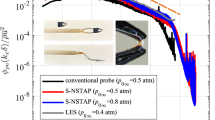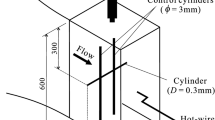Abstract
A comprehensive characterization of the thermal response of nanoscale hot-wire probes is performed in both subsonic and supersonic flows. A constant current anemometer was designed for the measurement of the intrinsic thermal inertia of hot-wire probes. In particular, the nanoscale probe is considered with the effect of gold-plating on the supporting structure of the sensing element. Gold-plated nanoscale probes present a response time one order of magnitude smaller than conventional cylindrical hot-wire probes. Heat transfer simulations show that the temperature profile is considerably modified by the addition of a conductive metal layer, hence increasing the sensor’s frequency response in both subsonic and supersonic flows. The increase of frequency response is finally exemplified by the numerical computation of the power spectral density of a turbulent flow signal without any electric compensation of the hot-wire signal.










Similar content being viewed by others
References
Bailey SC, Kunkel GJ, Hultmark M, Vallikivi M, Hill JP, Meyer KA, Tsay C, Arnold CB, Smits AJ (2010) Turbulence measurements using a nanoscale thermal anemometry probe. J Fluid Mech 663:160–179
Bruun H (1995) Hot-wire anemometry: principles and signal analysis. Oxford Science Publications
Byers CP (2018) Theoretical and experimental investigations of similarity solutions in turbulent flows. PhD thesis, Princeton University
Comte-Bellot G (1976) Hot-wire anemometry. Annu Rev Fluid Mech 8(1):209–231
Féry A (1928) Etude de la variation de la résistivité des couches minces de platine en fonction de leur épaisseur et de l’influence des corps oxygénés sur de semblables resistances. J Phys Radium 9(1):38–48
Hultmark M, Ashok A, Smits AJ (2011) A new criterion for end-conduction effects in hot-wire anemometry. Meas Sci Technol 22(5):055–401
Hutchins N, Monty J, Hultmark M, Smits A (2015) A direct measure of the frequency response of hot-wire anemometers: temporal resolution issues in wall-bounded turbulence. Exp Fluids 56(1):1–18
King L (1914) On the convection of heat from small cylinders in a stream of fluid: determination of the convection constants of small platinum wires with applications to hot-wire anemometry. Philos Trans R Soc Lond A 214(509–522):373–432
Kokmanian K, Scharnowski S, Bross M, Duvvuri S, Fu M, Kähler C, Hultmark M (2019) Development of a nanoscale hot-wire probe for supersonic flow applications. Exp Fluids 60(10):1–10
Kokmanian K, Barros D, Hultmark M, Dupont P (2021) Heat transfer measurements of a nanoscale hot-wire in supersonic flow. Exp Fluids 62(8):1–13
Kovasznay L (1950) The hot-wire anemometer in supersonic flow. J Aeronaut Sci 17(9):565–572
Le-The H, Küchler C, van den Berg A, Bodenschatz E, Lohse D, Krug D (2021) Fabrication of freestanding Pt nanowires for use as thermal anemometry probes in turbulence measurements. Microsyst Nanoeng 7(1):1–11
McAdams WH (1954) Heat Transmission, vol Chap. X. McGraw-Hill Book
Proença A, Lawrence J, Self R (2019) Measurements of the single-point and joint turbulence statistics of high subsonic jets using hot-wire anemometry. Exp Fluids 60(4):1–17
Schreyer AM, Lasserre JJ, Dupont P (2015) Development of a dual-PIV system for high-speed flow applications. Exp Fluids 56:187
Vallikivi M, Smits A (2014) Fabrication and characterization of a novel nanoscale thermal anemometry probe. J Microelectromech Syst 23(4):899–907
Acknowledgements
The authors gratefully thank Dr. Katherine Kokmanian for her advices during the preparation of the NSTAP probes.
Funding
This work was supported by AFOSR/EOARD under the grant award FA8655-20-1-7040 monitored by Dr. Douglas R. Smith.
Author information
Authors and Affiliations
Corresponding author
Ethics declarations
Conflict of interest
The authors declare no conflict of interest.
Additional information
Publisher's Note
Springer Nature remains neutral with regard to jurisdictional claims in published maps and institutional affiliations.
Rights and permissions
Springer Nature or its licensor (e.g. a society or other partner) holds exclusive rights to this article under a publishing agreement with the author(s) or other rightsholder(s); author self-archiving of the accepted manuscript version of this article is solely governed by the terms of such publishing agreement and applicable law.
About this article
Cite this article
Brunier-Coulin, F., Barros, D.C., Piqué, A. et al. Thermal response of a nanoscale hot-wire in subsonic and supersonic flows. Exp Fluids 64, 8 (2023). https://doi.org/10.1007/s00348-022-03545-z
Received:
Revised:
Accepted:
Published:
DOI: https://doi.org/10.1007/s00348-022-03545-z




